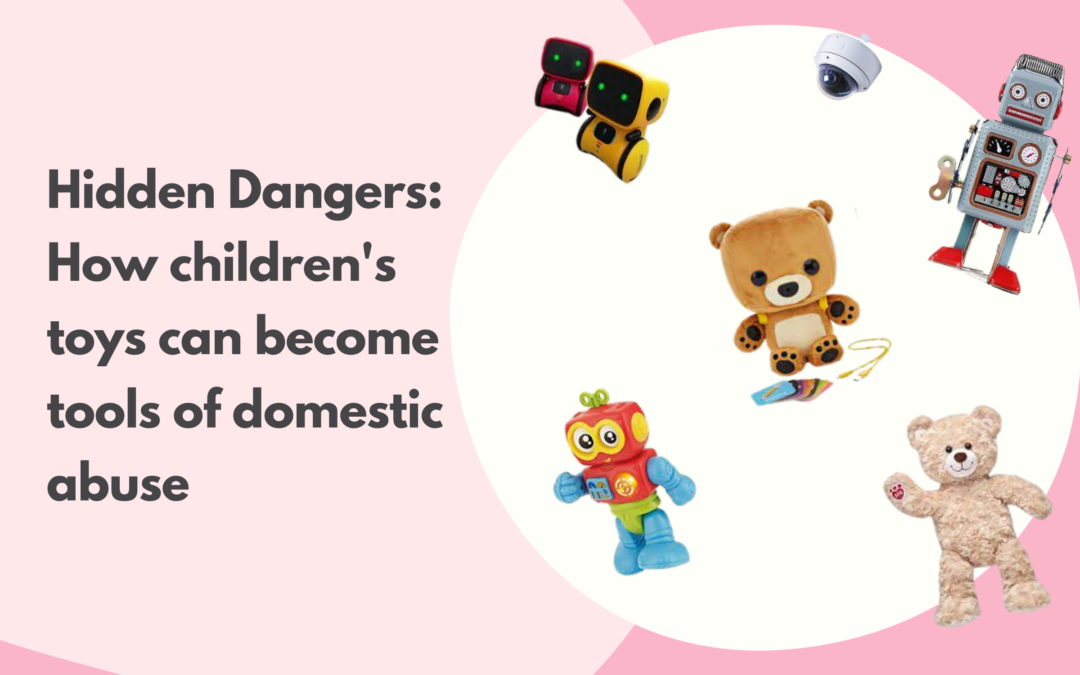We live our lives online, and although tech provides information and support to survivors of domestic abuse, it also gives perpetrators more ways to track and control someone.
Here, we’re taking a look at how children’s ‘smart toys’ can be used by perpetrators. We’ll look at:
- What exactly are ‘smart toys’
- Examples of some popular toys on the market
- What are the concerns for survivors
- Tips for working with survivors

What are ‘smart toys’?
Also known as connected or the Internet of Toys (IoToys), smart toys are equipped with tech such as sensors, microphones, cameras, data storage, speech recognition, GPS and internet connectivity, allowing them to interact with children and respond to their actions. These toys can provide interactive experiences for children, using features like voice recognition, artificial intelligence, and augmented reality.
The use of smart toys is rapidly increasing and we are now seeing perpetrators use these to monitor and control their current or ex-partners.
Some examples?
- Connects to a smartphone app – like any device pairing
- Can talk and sing to the user
- Other functions include reminders for calming down, taking medication, tidying, being polite, turning off screens, talking about a problem
Intelino – the smart robot train
- Uses Bluetooth smart technology to communicate with a smartphone or tablet through the Intelino Play app
- Teaches users about science, tech, engineering, and maths through a robotics-based learning system
- Contains sensors and other tech that allow it to respond to its environment
And there are many more on the market.

So, what are the concerns for survivors of domestic abuse?
Other than possible issues around data privacy and exposing children to online grooming and bullying, perpetrators can easily buy smart toys on the internet or high street shops.
A report by University College London (UCL) found that, worryingly, it’s relatively easy for perpetrators to manipulate children’s smart toys to access private information, and ultimately track their ex-partner.
Much like other smart home devices, smart toys often lack basic safety features such as:
- Built-in encryption
- Password and data protection
- User authentication
- Regular audits and assessments
- Secure wireless connections
Survivors and specialist support services are reporting instances of perpetrators turning up in places where the survivor is, following an access visit. This Australian article gives more detail.
Main concerns
- Smart toys with GPS can be used to track the survivor’s location. For example, many children’s games consoles have built-in GPS and have been used in this way
- Smart toys are designed to track children’s movements and collect and store personal data from inside the home
- It’s possible to gain access to voice and video recordings in toys with microphones or cameras without providing authentication
- Perpetrators may also buy a normal teddy bear, doll, or other toy and hide a GPS tracking device, camera, or microphone to secretly track, record, or listen to survivors.
Working with survivors? What you can do
For anyone working with survivors, it’s now necessary to map out, not only the survivor’s devices, but the devices of their children too. But, it’s important to bear in mind that securing technology can sometimes escalate the abuse, regardless of whether the survivor is in the leaving or life apart phase of the abusive relationship.
So, consider these security tips for children’s smart toys with caution:
🔐 Use secure Wi-Fi
- Use a hard-to-guess password
🔐 Switch it off or unplug when the toy is not being used
- This usually stops the toy from collecting data
- If the toy has a camera, face it towards a wall or cover it with some tape
- Toys with mics can be put in places where it’s harder to hear conversations
🔐 Accept regular security updates
- This may fix security holes
🔐 Be vigilant
- Reputable companies that make toys with mics should offer ways for parents to delete stored information
- Manage any passwords related to toys rather than leaving this up to the child user.
Want a deeper dive?
- Sign up for Equation’s bi-monthly Technology and domestic abuse newsletter – everything you need for building skills in this area
- Book onto one of Equation’s training sessions How Perpetrators of Domestic Abuse use Technology or Image-Based Sexual Abuse (IBSA)
- Take a look at the Digital Breakup Toolkit an interactive guide that walks readers through securing their digital devices and platforms against potential tech abuse.
Got a question about tech abuse? Email techabuse@equation.org.uk
Is it abuse
Not sure if what you're experiencing is abuse?
Get help
Stalking advisory service
Find out more.
How you can help
No matter how much time, money or resources you can afford to give, your support will make a difference.
£10
Give monthly
Could pay for four children
to take part in our early intervention projects
£30
Give once
Could pay for one primary school child to receive our healthy relationship education program
Support equation
Check out the other ways you can support us

